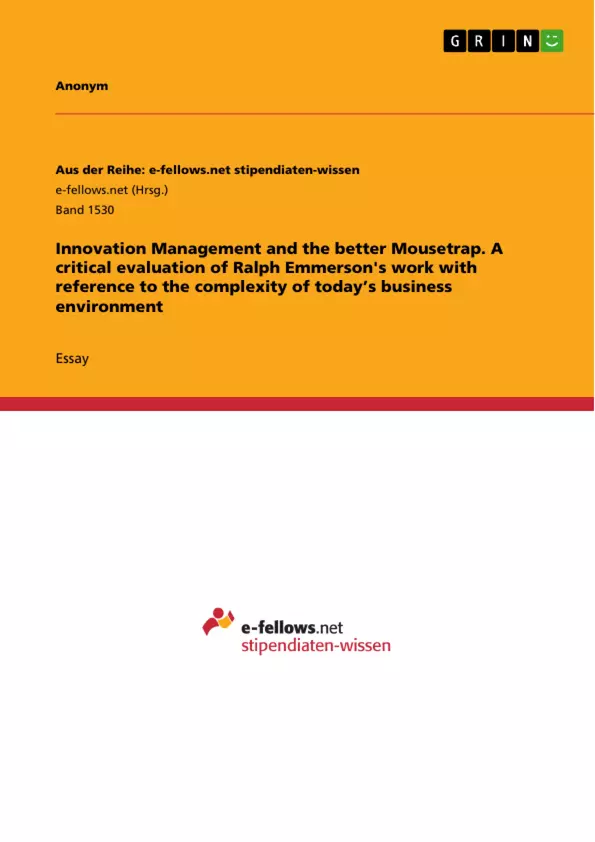“If a man can write a better book, preach a better sermon, or make a better mousetrap than his neighbour, though he build his house in the woods, the world will make a beaten path to his door.“
This famous statement coined by Ralph Waldo Emerson (1855) circumscribes metaphorically that superior products will attract the costumers with no need of marketing or other involvement in order to sell. Irrespective of the inventor’s track of record or degree of popularity, people will hustle over to the inventor in order to buy the product.
This report will critically evaluate the validity of Emerson’s statement especially taking into account the highly dynamic and complexity of today’s business environment. Moreover the process of innovation incorporating a close analysis in terms of types of inventions, implementation processes and the significance of entrepreneurship and technology transfer will be considered when evaluating Emerson’s statement.
Inhaltsverzeichnis (Table of Contents)
- INTRODUCTION
- INVENTIONS
- INCREMENTAL AND RADICAL INVENTIONS
- STRUGGLING INNOVATIONS AND MARKETING RELEVANCE
- ENTREPRENEURSHIP
- TECHNOLOGY TRANSFER
- CONCLUSION
Zielsetzung und Themenschwerpunkte (Objectives and Key Themes)
This report critically evaluates the validity of Emerson's statement regarding superior products attracting customers without marketing efforts, considering the dynamic and complex business environment. It analyzes the innovation process, including different types of inventions, implementation processes, entrepreneurship, and technology transfer.
- The relationship between innovation, inventions, and market success.
- The role of entrepreneurship and technology transfer in driving innovation.
- The impact of marketing and market demand on the success of inventions.
- The distinction between incremental and radical inventions.
- Examples of successful and unsuccessful inventions.
Zusammenfassung der Kapitel (Chapter Summaries)
- Introduction: Introduces Emerson's statement and its relevance to today's business environment. Outlines the report's scope and objectives.
- Inventions: Explores the concept of invention and provides examples of successful and unsuccessful inventions. Analyzes the role of creativity, technical competence, and market adoption in the success of inventions.
- Incremental and Radical Inventions: Discusses the different types of inventions and their implications for market success. Examines the relationship between innovation and invention.
- Struggling Innovations and Marketing Relevance: Addresses the challenges of introducing innovations to the market. Explores the impact of marketing and market demand on the success of inventions.
Schlüsselwörter (Keywords)
This report focuses on the intersection of innovation, invention, entrepreneurship, and technology transfer. It explores key themes like the impact of marketing on invention success, the distinction between incremental and radical inventions, and the role of entrepreneurship in driving innovation.
- Quote paper
- Anonym (Author), 2014, Innovation Management and the better Mousetrap. A critical evaluation of Ralph Emmerson's work with reference to the complexity of today’s business environment, Munich, GRIN Verlag, https://www.grin.com/document/303059



